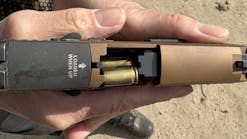Just as LET was set to publish its August issue, which focuses heavily on several training topics including an active shooter training event held on a university campus in early June, the appalling and tragic news of the movie theater shooting in Aurora, Colo., broke, changing the tone of several key features in the issue.
I was filing through the photo feature on Page 17 as I read about the gunman who opened fire on the packed theater’s show-goers; an eerie coincidence, I thought. Since then, I’ve come to see it as less of a coincidence and more so evidence of the fact that active shooter incidents—or active threat, as I’ve heard some industry veterans prefer—are happening with a troubling frequency. To interdict a shooter before he’s dolled up in his anti-hero wardrobe or marching under his long trench coat—as the boys who brought guns into Columbine High School in 1999 were—is difficult, though I’m sure future coverage of the killings in theater 9 will spend a lot of time rehashing it. (We won’t know the full scope of what happened there for awhile, since the investigation continues and authorities are under a court order limiting release of info to the public.)
John Czerwinski, a deputy sheriff with the Walworth County Sheriff’s Office in Elkhorn, Wis., has been a patrolman with the agency for 13 years, specializing in special weapons and tactics and an instructor teaching the discipline for the department and a local technical college for eight years. He’s also worked with the Midwest Tactical Officers Association for approximately three years, and helped irTactical and the Illinois Tactical Officers Association host the training event featured in “How to outdo a desperado.” That event took place six weeks prior to the early morning screening of “The Dark Knight Rises” where 70 people were gunned down, killing 12 of them. Czerwinski says incidents like the Aurora shooting lead him to consider what he’d do in a similar active threat response scenario, but there is really no right answer to prepare yourself, and instead, simply training regularly with one’s team is the best option.
“The opportunity to train with the people that you work with and train the techniques and tactics that will allow you to move efficiently through a building is invaluable,” Czerwinski says. “I don’t care what the training system is, whether it be blue guns, [Simunitions], airsoft, or irTactical equipment, being able to get together with your guys and work movements and work the communications skills that it takes to move is invaluable.” This is, prior to the news of the Aurora theater shooting, the notion behind our training issue.
That LET’s cover story for the same issue that was published just shy of the massacre at the Colorado cinema is on active shooter training technology is less of an eerie coincidence and better representative of a law enforcement standard of practice. It’s a testament to the industry’s dedication to training.
“That type of training pays off in spades [if] an incident like [the theater shooting in Aurora] happens and you’d have to go into a building and attempt some type of rescue,” Czerwinski says.
My predecessor, former LET editorial director Ronnie Garrett, used to sign her editorials with “Stay safe.” I’ll repeat her words and wish you all to stay safe.
And when you can’t be safe, be prepared.

Tabatha Wethal | Editor
Award-winning writer Tabatha Wethal is a previous editor leading Law Enforcement Technology magazine and assisted with other publications. She was with the magazines since 2007.


